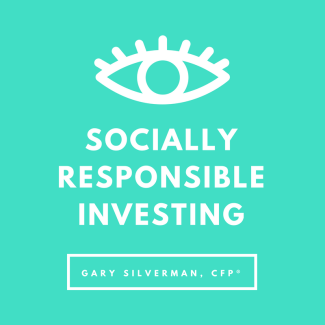
How to Create Diversity in Socially Responsible Investing
By Gary Silverman, CFP®
Last time we started looking at Socially Responsible Investing (SRI). We saw that mutual funds working in this area can use one of two methods to screen what stocks (or, less frequently, bonds) to have in a portfolio. One method looks at reasons to exclude a company. The other looks at reasons to include a company. There’s actually a hybrid method that does a bit of both. For instance, a fund that promotes clean energy might start with a list of S&P 500 stocks and then exclude from it companies in the fossil fuel industry. They could then add to this whittled down list companies that are in the renewable energy business but aren't part of the index.
Whether looking for a particular cause to support or one that you want to diminish you are purposely reducing your investment choices. Regular readers of this column will remember that I, more often than you might want to hear, preach diversification. I want your money divided among a variety of investment types and inside those investment types I want your money divided up among a variety of companies. The benefit is that you will tend to have a lot less volatility (risk) in your portfolio this way and through the magic of rebalancing (another theme I cover ad nauseum) you can at the same time actually increase your returns. It’s the only free-lunch I know of in investing.
Most often in the hybrid method, often in the exclusion method, and sometimes in the inclusion method of SRI you still have a widely diverse universe of companies to choose from to create your investment portfolio. But if your (or the fund’s) screens limit your selection to a point that it is heavy in only one or two industries, a small geographic area, or just a handful of companies, then beware. That doesn’t mean you won’t use that fund, but you should consider using it as a side investment rather than one in which to put the majority of your money. It could make your portfolio too volatile otherwise.
One thing you probably shouldn’t worry too much about is return. Ask the non-SRI community and they’ll tell you that they can get a better return due to having more companies to choose from. Ask the SRI community and they will tell you that due to their screens the companies they are left with will perform better than average so your return will be better not worse. Interestingly, the numbers bear out both arguments. My take on it is that unless you are left with the too-concentrated portfolio I warned about earlier, you’ll be okay from an investment perspective either way.
In the end it is a good thing for you to do the good thing, however you define it. Your conscience will be a little clearer, you’ll feel better about your actions, and you might sleep a bit better. I’m guessing that many of you will find that of better value than an extra 0.1% of return this year.
For the rest of you, just ignore this article and the last one.
Gary Silverman, CFP® is the founder of Personal Money Planning, LLC, a Wichita Falls retirement planning and investment management firm and author of Real World Investing

